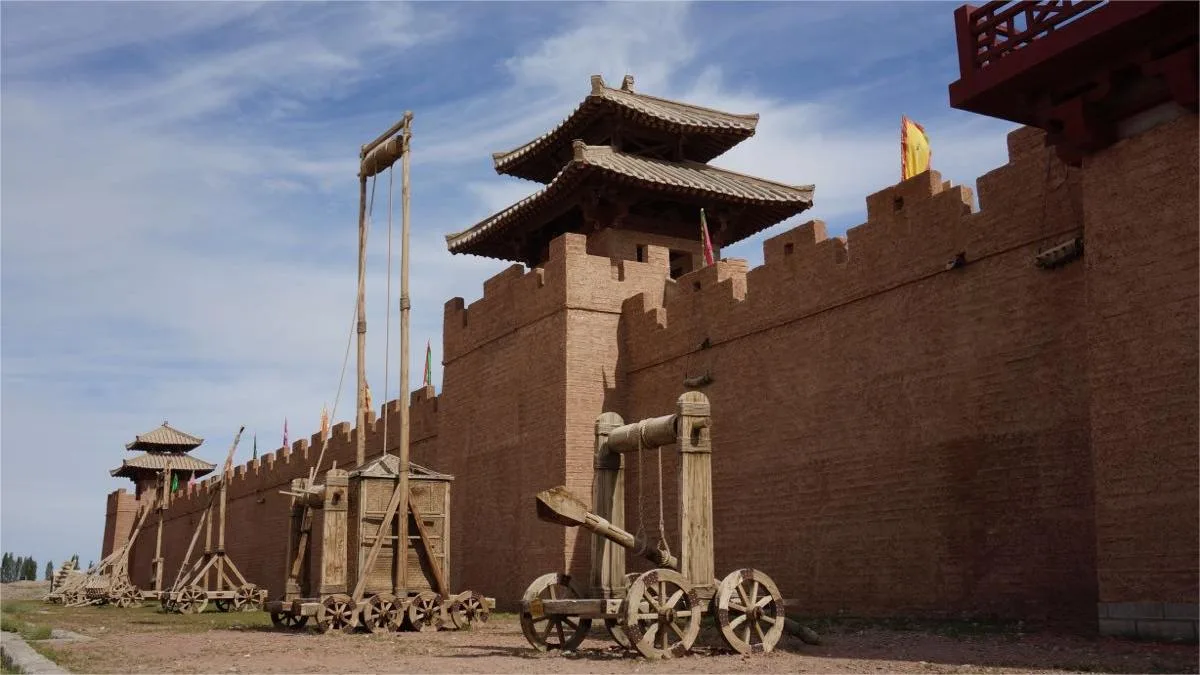Yangguan Pass, located in China, was a crucial chokepoint on the ancient Silk Road, serving as a gateway for overland trade. Built during the Western Han Dynasty under Emperor Wu around the 1st century BCE, Yangguan Pass played a significant role as a frontier fortress and one of the earliest customs posts in ancient China. Its name derives from its location south of Yumen Pass.
Between Yumen Pass and Yangguan Pass, sections of the Great Wall once connected them, while south of Yangguan Pass, there were also defensive walls. Today, the Yangguan Pass Scenic Area preserves numerous relics from the Han Dynasty, including the ruins of Yangguan Pass itself, ancient beacon towers, the ancient road of Yangguan, the ruins of Shouchang City, remnants of the Han Great Wall, the relics of Han Dynasty Wo Wa Chi, Xitugou (Tang Wulujian) site, ancient tombs, ancient kilns, and other cultural artifacts.
As a testament to its historical significance, Yangguan Pass remains an important archaeological site and a symbol of China’s ancient trade routes and military defense systems during the Han and Tang dynasties.
Table of Contents
- Basic Information
- Location and Transportation
- Map of Yangguan Pass
- Highlights of Yangguan Pass
- Vlog about Yangguan Pass
- Other Attractions in West Dunhuang
Basic Information
| Estimated Length of Tour | 1 – 2 hours |
| Ticket Price | 50 RMB |
| Sight-seeing Car | 10 RMB |
| Opening Hours | 8.00 – 21.00 (1st April – 31st October) 8.30 – 19.30 (1st November – 31st March) |
| Telephone Number | 0086-0937-8833089 |
Location and Transportation
Yangguan Pass is located approximately 70 kilometers southwest of Dunhuang City in Gansu Province, near the Gudong Beach. To reach Yangguan Pass from Dunhuang, visitors typically need to hire a private car due to the distance and the lack of direct public transportation. Once at Gudong Beach, travelers can then take a local tricycle or horseback ride to Yangguan Pass. The round-trip transportation cost usually amounts to around 150 yuan.
Map of Yangguan Pass

Highlights of Yangguan Pass
Yangguan Beacon Towers

The beacon towers at Yangguan Pass were constructed using layers of soil and reeds, reaching a height of approximately 4.7 meters. They feature a rectangular base measuring 8 to 7.5 meters wide and a top measuring 8 to 6.8 meters wide. Climbing to the top of these towers offers panoramic views that stretch for tens of miles, earning them the nickname “Yangguan Eyes and Ears” (阳关耳目). Unlike the “single” formation of beacon towers at Yumen Pass, those at Yangguan Pass are arranged in a “十” (cross) shape, radiating from the central Yangguan Pass site. They extend eastward to landmarks like Dadun, Shanque, and Baishan Beacons towards Dunhuang Commandery; southward to landmarks like Nandun and Yuanshanzi Beacons into Qinghai; westward to landmarks like Qingshanliang, Haiziwan Dong, Xidun, Hulusitai Dong, and Xidun Beacons into Xinjiang; and northward to landmarks like Toudun, Erdun, and Lucaoji Beacon, linking with Yumen Pass. These structures, along with military stations and defensive walls such as Duwei and Houguan, form an extensive defense system showcasing Yangguan Pass’s strategic importance.
Xitugou Site

Xitugou is a ravine that flows northwestward. It was named “Wulujian” during the Tang Dynasty. According to the “Map of Sha Zhou,” it is described as follows: “Wulujian, 50 steps wide, cliff depth of 1 zhang and 5 chi (approximately 4.5 meters), water width of 8 chi (approximately 2.6 meters), and depth of 3 chi (approximately 1 meter). From the ancient city of Yangguan in the southwest of the county, it flows north to the west of Shimen Beacon, westward into the boundary of the ancient city of Shouchang, spanning about 20 li (approximately 10 kilometers). The water here is non-saline, hence the name ‘Wulujian.'” Alongside this ravine, there are ancient tomb groups, remnants of ancient kilns, and beacon towers such as Huangyadong, Xitugouxi, Nandun, and Hongquanba.
Replica of Yangguan Fortress

The Replica of Yangguan Fortress is meticulously recreated based on historical records from the “Map of Sha Zhou,” which describes the main gate of the ancient Yangguan Fortress as being 20 steps wide east-west and 27 steps wide north-south. The replica embodies a grand and ancient simplicity, proudly displaying the majesty of Han architecture and reflecting historical aesthetics. As a symbol deeply ingrained in Chinese traditional culture, Yangguan has become synonymous with bidding farewell to loved ones and departing on long journeys, embodying sentiments of parting and nostalgia. Yangguan Road symbolizes the pathway to hopeful visions and the prosperity of ancient roads.
Yangguan Museum

Located in the heart of the scenic area, the Yangguan Museum is situated 800 meters south of the beacon tower ruins and adjacent to the ancient dune flats where the Yangguan ruins are located. To the east lies the site of the Tang Shouchang City and the ancient Han Woqiaochi. Heading southwest, the Southern Silk Road winds through rugged mountains and hills. The nearby Desert Forest Park boasts dense foliage, towering ancient trees, and numerous hidden springs and streams that gently flow through the landscape. From elevated vantage points, visitors can behold the magnificent panoramic views encompassing the snowy peaks of Altun Mountains (formerly known as Jin’an Mountain), vast deserts, and the expansive grandeur of the wilderness.





